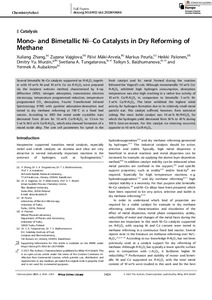Mono- and Bimetallic Ni-Co Catalysts in Dry Reforming of Methane
Murzin Dmitry Yu.; Aubakirov Yermek A.; Baizhumanova Tolkyn S.; Zhang Xuliang; Palonen Heikki; Peurla Markus; Mäki-Arvela Päivi; Vajglova Zuzana; Tungatarova Svetlana A.
https://urn.fi/URN:NBN:fi-fe2021093048665
Tiivistelmä
Several bimetallic Ni-Co catalysts supported on theta-Al2O3 together with 10 wt % Ni and 10 wt % Co on theta-Al2O3 were prepared via the incipient wetness method, characterized by X-ray diffraction (XRD), nitrogen adsorption, transmission electron microscopy, temperature programmed reduction, temperature programmed CO2 desorption, Fourier Transformed Infrared Spectroscopy (FTIR) with pyridine adsorption-desorption and tested in dry methane reforming at 700 degrees C in a fixed bed reactor. According to XRD the metal oxide crystallite sizes decreased from 20 nm for 10 wt % Co/theta-Al2O3 to 13 nm for 5 wt % Ni-5 wt % Co/theta-Al2O3, which also showed formation of a mixed oxide alloy. The unit cell parameters for spinel in the fresh catalyst and fcc metal formed during the reaction followed the Vegard's rule. Although monometallic 10 wt % Co/theta-Al2O3 exhibited high hydrogen consumption, desorption temperature was also high resulting in a rather low activity of 10 wt % Co/theta-Al2O3 in comparison to bimetallic 5 wt % Ni-5 wt % Co/theta-Al2O3. The latter exhibited the highest initial activity for hydrogen formation due to its relatively small metal particle size. This catalyst suffered, however, from extensive coking. The most stable catalyst was 10 wt % Ni/theta-Al2O3 for which the hydrogen yield decreased form 56 % to 45 % during 100 h time-on-stream. For this catalyst no sintering occurred, opposite to 10 wt % Co/theta-Al2O3.
Kokoelmat
- Rinnakkaistallenteet [19249]
